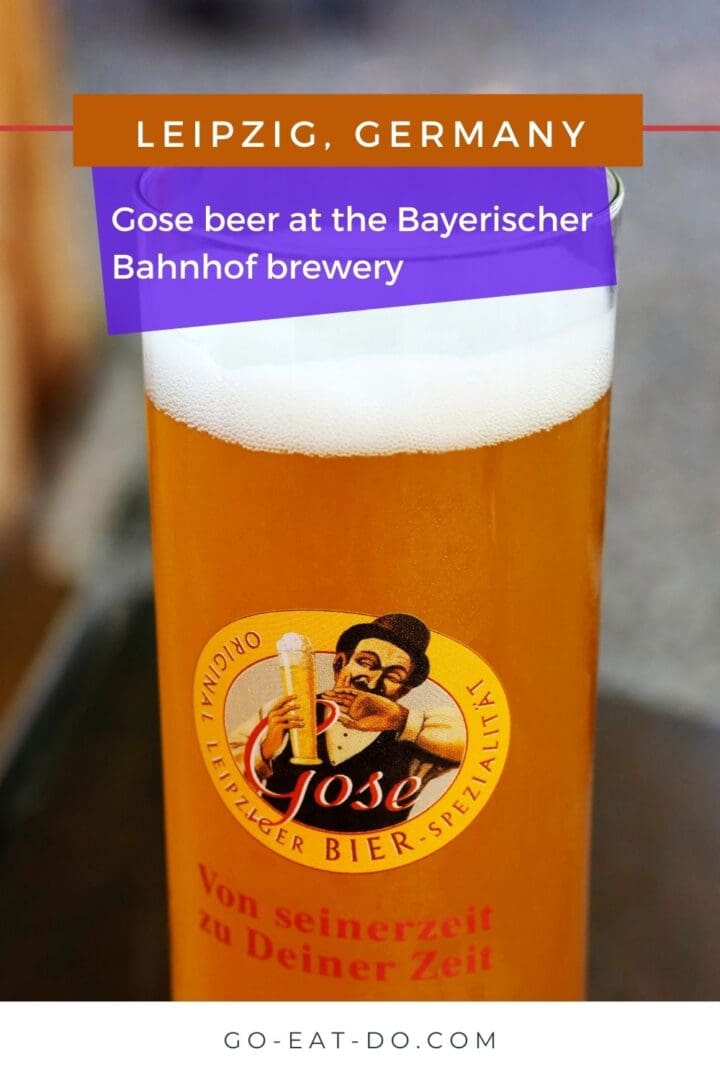Stuart Forster travels to Saxony in eastern Germany and visits the Leipzig Bayerischer Bahnhof brewery.
Leipzig’s Bayerischer Bahnhof has claims to being the world’s oldest railway terminal. That significant piece of transport history isn’t what drew me here. I’ve come to sample gose, a style of beer brewed onsite in the microbrewery.
Thanks to the Reinheitsgebot, a beer purity law dating from 1516, most German breweries are permitted to brew using only hops, malt, yeast and water. Gose also features lactic acid, coriander and salt.
Brewing this style of beer in Bavaria would not be permitted. In Saxony brewing goes under licence from the government is allowed because the beer is a regional speciality. The style of ale pre-dates the introduction of the Reinheitsgebot.

Leipzig Bayerischer Bahnhof brewery
Matthias Richter is the Braumeister or brewmaster at the Gosebrauerei Bayerischer Bahnhof. He explains that gose was originally a spontaneously fermented style of beer drank in Goslar during medieval times. Its name is derived from the River Gose, which flows through the attractive town in the Harz Mountains.
According to legend, gose was first brought to Leipzig in 1738. In the upheaval of the Napoleonic era, gose fell out of favour in Goslar. Yet drinkers in Leipzig and nearby Halle continued to consume it.
Over time drinking fashions changed. Pilsners rose in popularity during the late 19th century and demand for gose dwindled. In 1966 the last batch of gose was brewed but the recipe was saved.

Gose beer in Leipzig
Clearly passionate about brewing history, Matthias explains how a couple of attempts were made to revive gose in the 1980s. The fall of the Berlin Wall resulted in a Franconian brewer investing in premises in Leipzig.
Matthias stands in front of polished copper tanks within the pub-restaurant on the site of the railway terminus constructed between 1842 and 1844. He tells me that regular gose contains 4.5 per cent of alcohol by volume. The double bock version weighs in with at least twice that much booze.
Barley and wheat both feature in the brew, which is made in 1,500-litre batches. The fermentation tanks at the Gosebreuerei hold double that amount.
Most of the beer Matthias brews is sold on site but around a fifth of the capacity is exported. Gose has admirers as far afield as the USA, Italy, Finland, Norway and Denmark.
The brewer leads me to stainless steel tanks that make it possible for the brewery to produce around 250 hectolitres of beer a year. Meanwhile, he describes how he enjoys the multifaceted nature of his work. In addition to gose, he brews black beer, wheat beer, pilsner and a handful of speciality ales.
He is clearly proud of his spruce needle gose. “Spruce needles were used to filter the wort,” he explains.

Tasting Leipzig’s gose beer
After showing me a bottle of the liqueur also sold in the pub-restaurant, Matthias heads back to work. I step outside into the beer garden and take a seat. A server takes my order for a plate of spare ribs and a glass of gose.

The beer is by no means as tangy as I’d anticipated. I’d expected that because of the lactic acid during the brewing process. On a summer day, it proves a palatable, refreshing drink that pairs well with the ribs.

Map of the Bayerischer Bahnhof Leipzig
The map below shows the location of the Bayerischer Bahnhof in Leipzig:
Travel to Leipzig, Germany
Leipzig/Halle Airport is 22 kilometres (13.7 miles) northwest of Leipzig’s city centre. The S5 and S5X run between the airport and the city centre. InterCity trains also connect the city centre (Leipzig Hauptbahnhof) and airport.
Leipzig has good rail connections with other German cities.

Books about Leipzig, Germany and German beer
Interested in visiting Leipzig? You may enjoy these books about Leipzig, Germany and German beer:
Gose: Brewing a Classic German Beer for the Modern Era by Fal Allen.
The Creation of RB Leipzig: Authentic identity or self-deception by Martin Wenzl.
The Shortest History of Germany by John Hawes.
Leipzig Highlights: The Practical Guide for Discovering the City.
Further information
The Gasthaus & Gosebrauerei Bayerischer Bahnhof (Bayerischer Platz 1, Leipzig; tel. +49 (0) 341 1245760) is both a brewery and a pub-restaurant with a beer garden.
The Italian-influenced, Neoclassical railway building was once a point of departure for rail journeys to Hof, in Bavaria, and then southwards to Austria and Italy. A second building, on the opposite side of the track, was destroyed by allied bombing during World War Two. It is a short walk from the centre of Leipzig.
Take a look at the Leipzig Travel website for an overview of the city’s attractions and how to make the most of a visit.
Leipzig is the most populous city in Saxony. The Saxony Tourism and Cultural Heart of Germany websites provide a wealth of ideas about what to see and do in the state.
See the Germany Travel website for ideas about things to do and see in Saxony and elsewhere in the country.
Enjoy this post about Leipzig’s Bayerischer Bahnhof brewery? Take a look at this one about the rise of RB Leipzig football club.
Stuart Forster, the author of this post, speaks fluent German and is a member of the British Guild of Beer Writers. He can be commissioned to write features from destinations in Germany and German-speaking nations.
Photos illustrating this post are by Why Eye Photography.
If you enjoyed this post why not sign up for the free Go Eat Do newsletter? It’s a hassle-free way of getting links to posts on a monthly basis.
‘Like’ the Go Eat Do Facebook page to see more photos and content.
A version of this post was first published on Go Eat Do on 29 October 2016.




